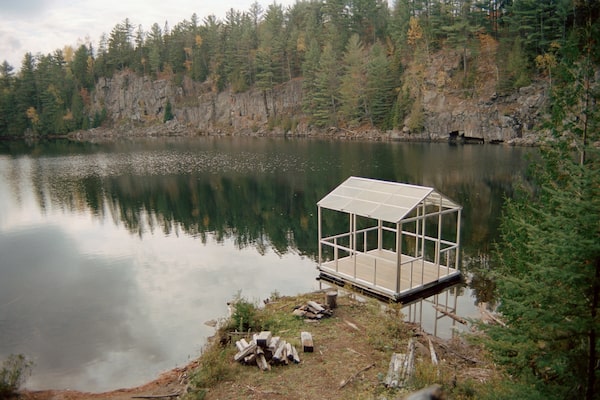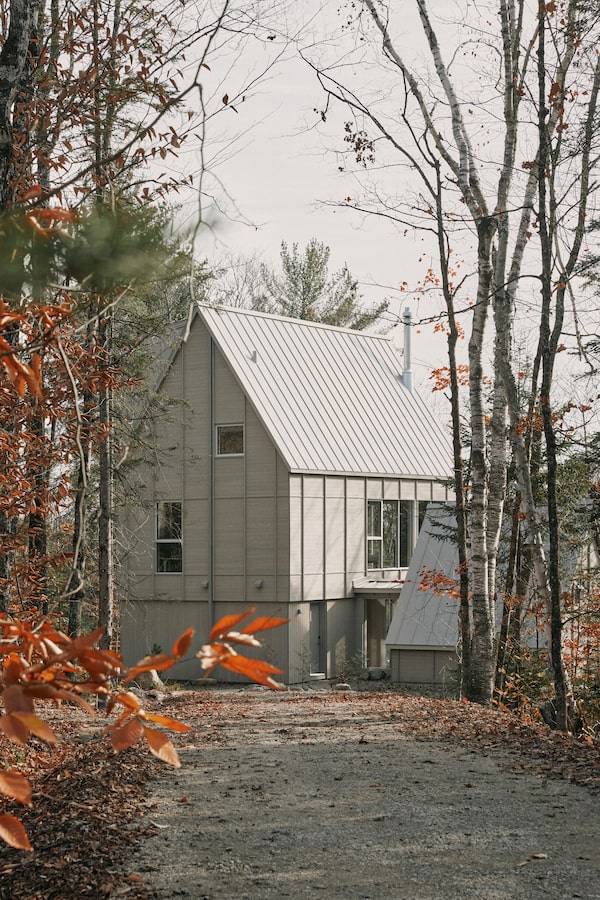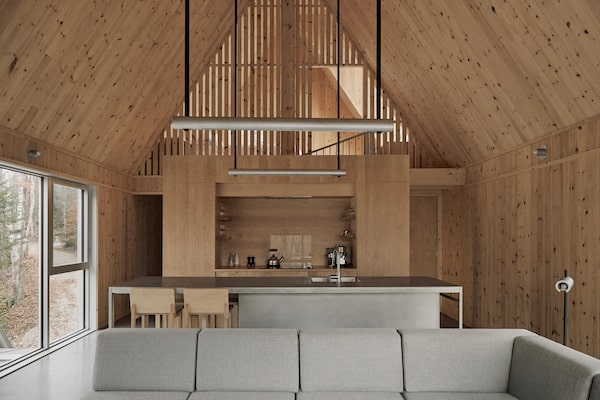
Marie H Rainville/The Globe and Mail
It was dark when I arrived at Beside Habitat, a new, master-planned community of 75 architectural cabins spread over 485 hectares an hour north of Montreal. In the night, obscured by a dense forest of trees, details in the landscape were hard to discern. On the road in, I could only glimpse a few of the steep, peaked roofs that top the cottages. My drive from Toronto had been long and frustrating but I felt an instant sense of calm when I got out of the car and smelled fresh pine in the air.
That first night, in almost complete silence, I poked around inside my cottage. The great room soared up to a cathedral ceiling. A muscle-melting sauna in the spa-like bathroom beckoned. In the middle of the space was a wood stove with a built-in cooktop where you could fry an egg while warming your toes.
The next morning, I woke up in a loft above the kitchen wrapped in yards of white bedsheets, bright light flooding through a tall picture window. According to the architect of the development, Kim Pariseau of Montreal’s Appareil Architecture, each structure is sited to avoid any awareness of neighbours. As I made my way down for breakfast, all I could see outside were bluejays hopping from branch to branch.
Throughout the day, with the rural internet connection weak enough to calm any impulses to work, I simply sat by the window. As the sun arched across the sky, the shadows of the trees swept across the living room floor like hands on a clock. The cabin’s concrete floor, pine walls and plywood cabinets all captured a humble way of living but there was an unquestionable hint of luxury in the restorative way the design forged a connection with the natural world outside. Instead of the pandemic blur of one moment fading meaninglessly into the next, I became acutely, happily aware of passing hours. As each new bird fluttered in and out of view, time started to mean something again.

Marie H Rainville/The Globe and Mail
Beside Habitat’s ethos entreats people to “experience architecture in nature.” On a tour of the property, Hugues Fournel, a retired Olympic kayaker and the site’s general director, said that the goal of the project is to connect people and the great outdoors. The cabins, which are still being developed, are each privately owned but many are available to rent through the community’s online hub.
This kind of design-centric project is being offered up at an opportune time in Canada. Demand for cottages is exploding. According to Remax, the price of second homes in the country increased by at least 15 per cent in 2021, with bumps of up to 70 per cent in some regions. The trend has been driven by buyers eager to get away from cramped and pricey urban addresses – and has been further fuelled by the lucrative short-term rental income a stylish and well-maintained property can earn. Many people are also making the decision to leave cities altogether. Between 2020 and 2021, nearly 50,000 people departed Montreal, the highest drop in 20 years, according to the Institut de la statistique du Québec. A similar number left Toronto during the first year of the pandemic.

Marie H Rainville/The Globe and Mail
Toronto architect Brenda Izen has been busier than ever designing country homes and sees many homeowners eschewing monster cottages in favour of modest, easier to maintain spaces like the Beside houses. “A large footprint can present a number of challenges,” she says. “If you’re doing a massive house, that’s more than one storey, you don’t have a lot of opportunity for skylights to get natural light into the core of the home and into the central rooms. And the deeper you are in the house, the farther you are from the windows and the relationship with nature.”
To Izen, there is an inverse relationship between size and enjoying a rustic site. “It’s almost like those little one-bedroom cabins in the woods where everything is really consolidated. That’s where you have the best connection,” she says.
The cabin I visited at Beside Habitat belongs to Nicholas Dumensil, a former tech executive who bought the property preconstruction before the pandemic. He wasn’t looking for a cottage but became intrigued when a friend posted a link to the project on social media. “It ticked every box,” he says. “Architectural construction, turnkey, simple.”
Dumensil had to select his layout from a series of plans proposed by designer Appareil but the finishes, furniture and overall contemporary aesthetic were all fixed. The upkeep and rental of his place, which was booked for almost 11 months last year and can cost renters up to $340 per night depending on the season, are managed by Beside, a company that also produces a popular outdoor life magazine of the same name.

Marie H Rainville/The Globe and Mail
Something else that appealed to Dumensil: While Beside’s developers plan to incorporate community buildings including a music studio and café into the property, 80 per cent of the site is protected from any further development.
One day, hiking through the backwoods, which includes several pristine lakes and ponds, Dumensil bumped into one of Beside’s founders and expressed how much he loved the concept. The conversation turned into a job offer and Dumensil is now Beside’s chief financial officer.
Although Dumensil only spends about 35 days a year at his place, some of his fellow owners don’t rent their cabins out at all, preferring to spend longer stretches of time away from Montreal or Quebec City. The community is located in Rawdon, a small town that has long been used as an escape from one world and a way to reconnect in another. One hundred years ago, it saw an influx of Russians – including a few aristocrats – seeking refuge from the revolution. Two onion-domed chapels remain as a legacy of this migration, one on a street called Rue de Petrograd, an old name for St. Petersburg.
Although far from home, the new arrivals appreciated Rawdon because the thick pine forest reminded them of where they had come from. Today, it creates a similar grounding effect for a new community seeking out the comforts of nature.



